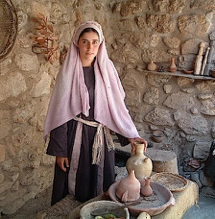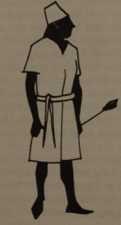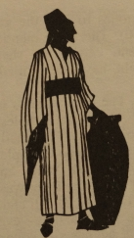N.B.: I am in the Holy Land at this time. As my travel schedule is heavy, I am republishing some articles about life in Jesus’ day. I hope you will enjoy reading (or re-reading) them as much as I did.
 Determining what clothing was worn in Jesus’ day is surprisingly complex. First of all, there are many presumptions we make based on how many dress in the Middle East today. The typical form of clothing there now (the women in veils, and both men and women in long, flowing robes) seems very traditional and ancient to us, so we assume that this is how the people of Jesus’ time dressed. Even if many of the basics are the same, the details are difficult to determine.
Determining what clothing was worn in Jesus’ day is surprisingly complex. First of all, there are many presumptions we make based on how many dress in the Middle East today. The typical form of clothing there now (the women in veils, and both men and women in long, flowing robes) seems very traditional and ancient to us, so we assume that this is how the people of Jesus’ time dressed. Even if many of the basics are the same, the details are difficult to determine.
This difficulty emerges from two basic problems. First, archeology unearths little evidence of ancient clothes, since they do not last like rocks, pottery, and some bones. Second, the Jews almost never represented human figures in their art, so we have nothing comparable to the Egyptian frescoes, or the artwork found from the ancient Greeks and Romans.
We are left to glean details from scriptural references to clothing and descriptions of what was required and forbidden. Although they do not paint a complete picture, they at least provide us with some rudimentary descriptions.
In everyday life, men and women alike wore garments often referred to as “tunics.” A tunic was a simple, one-piece robe, usually belted at the waist, with a hole for the head and two holes for the arms. People wore both an inner garment and an outer garment, each with a similar shape.
 The inner garment resembled a long, loose-fitting T-shirt or a kimono. It was made of linen, cotton, or sometimes soft wool. For penitential reasons some would occasionally wear inner tunics made of sackcloth or camel hair. The earliest of these garments were made without sleeves and reached only to the knees; later the garment often extended to the wrists and ankles. A man wearing only this inner garment was said to be naked (e.g., 1 Samuel 19:24, Isaiah 20:2–4). Nothing at all was worn underneath the inner garment (except by Essene men, who wore a close-fitting loincloth).
The inner garment resembled a long, loose-fitting T-shirt or a kimono. It was made of linen, cotton, or sometimes soft wool. For penitential reasons some would occasionally wear inner tunics made of sackcloth or camel hair. The earliest of these garments were made without sleeves and reached only to the knees; later the garment often extended to the wrists and ankles. A man wearing only this inner garment was said to be naked (e.g., 1 Samuel 19:24, Isaiah 20:2–4). Nothing at all was worn underneath the inner garment (except by Essene men, who wore a close-fitting loincloth).
The belt (also called a cincture or girdle) was a band of cloth, cord, or leather that could be loosened or tightened. It was worn around the inner and/or outer garment. Its use prevented the flowing robes (often long) from interfering with movement. The biblical expression “to gird up the loins” meant to put on the belt, thus freeing the lower legs to permit work and easy walking. The expression signified that the person was ready for service; it is largely equivalent to the modern expression, “roll up your sleeves.”
 The outer tunic, also called a mantle or robe, was worn over the inner tunic. It consisted of a square or oblong strip of cloth with a hole for the head. Sometimes it had sleeves and sometimes was more like a poncho, with the area for the arms cut back. It was worn as a protective covering; people did not go out in public without some sort of outer tunic. Jewish men had tassels (called tzitzit) attached to the corners of their mantles, reminding them of the constant presence of the Lord’s commandments. Because the outer tunic was large and flowing, it was usually drawn in with a belt. The outer belt was often decorated with embroidery or even precious stones.
The outer tunic, also called a mantle or robe, was worn over the inner tunic. It consisted of a square or oblong strip of cloth with a hole for the head. Sometimes it had sleeves and sometimes was more like a poncho, with the area for the arms cut back. It was worn as a protective covering; people did not go out in public without some sort of outer tunic. Jewish men had tassels (called tzitzit) attached to the corners of their mantles, reminding them of the constant presence of the Lord’s commandments. Because the outer tunic was large and flowing, it was usually drawn in with a belt. The outer belt was often decorated with embroidery or even precious stones.
A bag or purse was often attached to the belt, fastened with a buckle.
While most Jewish men and women wore long (ankle-length) tunics, short (knee-length) tunics were worn by slaves, soldiers, and those engaging in work that required mobility.
The cloak – In cooler weather, a cloak might be worn on top of these tunics. Cloaks could be designed either with sleeves or without.
Sandals were worn on the feet. They had wooden soles and were fastened with straps of leather. Jews did not wear sandals indoors; they removed them upon entering the house and washed their feet.
In terms of the basics, men and women dressed much alike. However, there were clearly differences because Scripture warns, A woman shall not wear man’s clothing, nor shall a man put on a woman’s clothing; for whoever does these things is an abomination to the LORD your God (Deut 22:5).
For women, the inner garment was largely identical to that for men. However, the outer garment was longer, with enough border fringe to largely cover the feet (Isaiah 47:2; Jeremiah 13:2). The outer garment was cinched with a belt similar to that used by men, but it was ornamented differently (and usually more elaborately). In some regions, women’s outer garments were made of different materials and/or sported different patterns than those worn by men. In addition, a woman might don an apron on top of the outer garment, in order to protect it and to enable her to carry things. The apron was usually attached to the belt and covered the lower half of the body.
The veil – There is debate as to how widespread the wearing of the veil was for Jewish women in Jesus’ day. It is certain that they wore them in the synagogue and the Temple (cf 1 Cor 11:15). It is also quite certain that unmarried women wore them. However, it is less evident that Jewish women wore them all the time, especially at home; some of them didn’t even wear them in public. It would seem that Jewish women in Roman Judea (i.e., the south, around Jerusalem, Jericho, and Bethlehem) wore hairnets, examples of which have been discovered at sites such as Masada.
So perhaps women did not wear a veil at all times as is now the custom in much of the Middle East. Other sources speak of the head covering being typical for both men and women and describe it as a length of cloth around the shoulders that could be pulled over the head and tied at the forehead, falling over the shoulders. Perhaps the veil or head covering was something that was used strategically, such as when one needed protection from the sun or wished to pray.
The Bible first mentions women’s jewelry when Abraham’s servants present earrings and bracelets to Rebecca (Genesis: 24:22). Jeremiah also observed, “Can a maid forget her ornaments?” Isaiah 3:16-23 features a detailed description of the fashionably ornamented woman of the Old Testament. As a general rule, Hebrew women wore bracelets and earrings. Less frequently they might have nose jewels and/or wear a necklace.
Bracelets – Bracelets were usually made of precious materials such as gold and were typically worn around the wrist. However, royal women often wore them above the elbow. Most bracelets were one solid piece and were slipped over the wrist; more rarely two pieces were fastened together and were open and closed at a hinge.
Anklets – Women wore anklets as often as they did bracelets. Anklets were made of much the same material (Isaiah 3:16 – 20). Some anklets were fashioned so as to create a tinkling, musical sound when the woman walked.
Earrings – Among the Jewish people, only women wore earrings (Judges 8:24). They were less common long ago than they are today. Generally, Scripture suggests that they were round or hoop-like. However, the law prohibited all mutilation of the body, so neither ears nor nose could be pierced to hold such ornaments. Thus earrings were clipped on or worn around the ear with a small chain.
Nose Jewels – Although some evidence exists of Jewish women wearing small jewels on or about the nose, there is little evidence that the wearing the nose rings was widespread. The practice was more common farther to the east, mainly among the Assyrians and Persians.
Rings were worn not only on the fingers, but also on the toes.
Cosmetics and perfume – Generally, Jewish women looked at cosmetics (such as painting the eyes) with disdain (Jeremiah 4:30; 23:40). There is some evidence that Jewish women dyed the nails of their fingers and toes with henna.
Perfume – Jewish women used perfume in much the same manner as today. Common sources of perfume in biblical times were frankincense and myrrh, aloes, nard, cinnamon, and saffron.
Hairstyle – Most Jewish women wore their hair long and braided. The Talmud mentions that Jewish women also used combs and hairpins. It would seem that they generally eschewed the more elaborate hairstyles of the Greek and Assyrian women.


We linked to your article here
Thank you